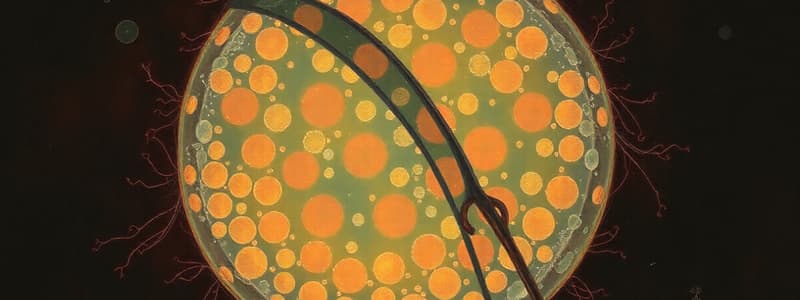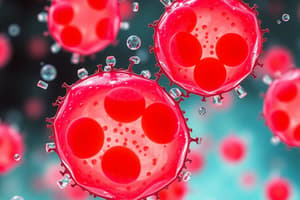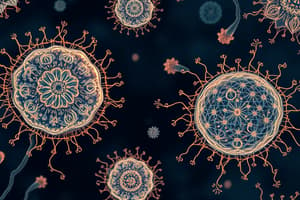Podcast
Questions and Answers
Which of the following is a key difference between prokaryotic and eukaryotic cells concerning their internal organization?
Which of the following is a key difference between prokaryotic and eukaryotic cells concerning their internal organization?
- Eukaryotes have membrane-bound organelles, while prokaryotes generally lack them. (correct)
- Prokaryotes have membrane-bound organelles, while eukaryotes do not.
- Eukaryotes have a single, circular chromosome, while prokaryotes have multiple linear chromosomes.
- Prokaryotes use ATP for locomotion, while eukaryotes use H+ pumps.
What is the role of the plasma membrane in prokaryotic cells?
What is the role of the plasma membrane in prokaryotic cells?
- It powers locomotion through ATP.
- It encloses the cell and contains all its contents, including the cytoplasm and genetic material. (correct)
- It contains the genetic material separate from the cytoplasm.
- It encapsulates task-specific structures called organelles.
Which statement accurately describes the genetic material in prokaryotes?
Which statement accurately describes the genetic material in prokaryotes?
- It consists of multiple linear chromosomes contained within a nucleus.
- It is composed of RNA.
- It is a single circular chromosome located within the cytoplasm. (correct)
- It is organized into membrane-bound organelles.
What is the hypothesized role of lipid membranes in the origin of life?
What is the hypothesized role of lipid membranes in the origin of life?
Which of the following is the proposed first step in the evolution of cells?
Which of the following is the proposed first step in the evolution of cells?
A scientist discovers a new unicellular organism. Initial analysis reveals it lacks membrane-bound organelles. How would this organism be classified?
A scientist discovers a new unicellular organism. Initial analysis reveals it lacks membrane-bound organelles. How would this organism be classified?
What key evidence supports the endosymbiotic theory for the origin of mitochondria and chloroplasts?
What key evidence supports the endosymbiotic theory for the origin of mitochondria and chloroplasts?
According to the endosymbiotic theory, which event likely led to the origin of mitochondria in eukaryotic cells?
According to the endosymbiotic theory, which event likely led to the origin of mitochondria in eukaryotic cells?
A cell is found to contain its own DNA and divide independently of the host cell. Which organelle is MOST likely being described?
A cell is found to contain its own DNA and divide independently of the host cell. Which organelle is MOST likely being described?
How did the infolding of the plasma membrane contribute to the evolution of eukaryotic cells?
How did the infolding of the plasma membrane contribute to the evolution of eukaryotic cells?
What is the significance of Rickettsia rickettsii in understanding endosymbiosis?
What is the significance of Rickettsia rickettsii in understanding endosymbiosis?
Which of these characteristics is NOT associated with mitochondria?
Which of these characteristics is NOT associated with mitochondria?
What is a key difference in locomotion between bacteria and archaea?
What is a key difference in locomotion between bacteria and archaea?
What evidence suggests that chloroplasts originated through endosymbiosis?
What evidence suggests that chloroplasts originated through endosymbiosis?
Following the endosymbiotic theory, what was the original function of the bacterium that eventually became the chloroplast?
Following the endosymbiotic theory, what was the original function of the bacterium that eventually became the chloroplast?
Hatena arenicola is a present-day species showing the hallmark of endosymbiosis. What happens when Hatena loses its symbiont?
Hatena arenicola is a present-day species showing the hallmark of endosymbiosis. What happens when Hatena loses its symbiont?
In endosymbiosis, what is the primary fate of most organelles from the ingested cell?
In endosymbiosis, what is the primary fate of most organelles from the ingested cell?
Which of the following puts the appearance of organelles in the correct evolutionary order?
Which of the following puts the appearance of organelles in the correct evolutionary order?
How are mitochondria and plastids considered semi-autonomous organelles?
How are mitochondria and plastids considered semi-autonomous organelles?
What is the central idea behind the endosymbiotic theory?
What is the central idea behind the endosymbiotic theory?
Flashcards
Organelles
Organelles
Structures within a cell that perform specific tasks and are enclosed by a membrane.
Prokaryotes
Prokaryotes
Cells lacking membrane-bound organelles; genetic material is a single, circular chromosome.
Eukaryotes
Eukaryotes
Cells with distinct organelles carrying out separate tasks; contains one or more linear chromosomes.
Plasma membrane
Plasma membrane
Signup and view all the flashcards
Genetic Material (Prokaryotes)
Genetic Material (Prokaryotes)
Signup and view all the flashcards
Nucleus
Nucleus
Signup and view all the flashcards
Mitochondria
Mitochondria
Signup and view all the flashcards
Chloroplasts
Chloroplasts
Signup and view all the flashcards
Protocells Hypothesis
Protocells Hypothesis
Signup and view all the flashcards
Origin of Organelles
Origin of Organelles
Signup and view all the flashcards
Endosymbiotic Theory
Endosymbiotic Theory
Signup and view all the flashcards
Origin of Mitochondria
Origin of Mitochondria
Signup and view all the flashcards
Origin of Chloroplasts
Origin of Chloroplasts
Signup and view all the flashcards
Mitochondria Autonomy
Mitochondria Autonomy
Signup and view all the flashcards
Chloroplast Autonomy
Chloroplast Autonomy
Signup and view all the flashcards
Prokaryotic Organelles
Prokaryotic Organelles
Signup and view all the flashcards
Study Notes
Differences Between Prokaryotes and Eukaryotes
- Prokaryotes may have compartments for specific tasks that are not membrane-bound.
- Archaea power their locomotion using ATP, but there are exceptions.
- Organelles are task-specific structures encapsulated in a membrane.
Prokaryotes
- Lack organelles.
- Possess a single, circular chromosome.
- Use H+ pumps for locomotion in bacteria.
Eukaryotes
- Have multiple distinct organelles each performing separate tasks.
- Contain one or more linear chromosomes.
- Use ATP for locomotion.
Prokaryotes
- The simplest cells contain a plasma membrane.
- The plasma membrane contains all of the cells contents.
- The genetic material is part of the cytoplasm.
- There is no internal membrane system or organelles
Event #1: Protocells
- Life may have begun when replicating molecules were enclosed in lipid membranes
- Some amphipathic molecules self-assemble into spheres following the second law of thermodynamics.
Event #2: Origin of Some Organelles
- The hypothesis is that the infolding of the plasma membrane became permanent internal structures.
- An example includes the nucleus and endomembrane system forming from this process.
Event #3: Origin of Mitochondria
- An early eukaryote engulfed an aerobic bacterium.
- Instead of digesting the bacterium, it was kept alive inside the eukaryote.
- This process is called endosymbiotic theory.
- Phagocytosis of bacteria by eukaryotes is commonplace.
- Some present-day prokaryotes can live inside cells they infect.
- Rickettsia rickettsii induces phagocytosis in epithelial cells.
- Mitochondria divide independently of the cell.
- Mitochondria contain their own DNA.
Event #4: Origin of Chloroplasts
- A mitochondriate eukaryote engulfed a photosynthetic bacterium.
- The photosynthetic bacterium was kept alive instead of being digested.
- This is another example of the endosymbiotic theory.
- Chloroplasts contain their own DNA, just like mitochondria.
- Chloroplasts may have three membranes.
- The multiple membranes suggests this happened multiple times
Present-Day Species: Hatena Arenicola
- Exhibits the hallmark of endosymbiosis
- Has a feeding tube when it doesn't have a symbiont
- Cannot divide or is not phototropic when it doesn't have a symbiont
- Keeps nucleus/chloroplast/ loses most organelles when ingesting a Nephroselmis
- Nephroselmis cannot divide
Studying That Suits You
Use AI to generate personalized quizzes and flashcards to suit your learning preferences.




